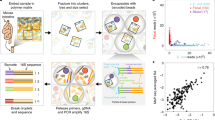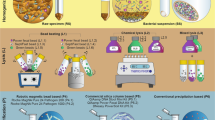Abstract
Recent studies have shown the microbial biofilms adherent to plant biomass in the gastrointestinal tracts of humans and other herbivores are quite different to planktonic populations. If these biofilm communities are to be properly characterized by metagenomics methods, then the microbial desorption methods used must ensure the phylogenetic diversity and genetic potential recovered is biologically valid. To that end, we describe here two different methods for desorbing microbes tightly adherent to plant biomass; and used PCR-DGGE analyses of the Bacteria and Archaea rrs genes to show both these desorption methods were effective in recovering the adherent microbial biofilm with no apparent biases in microbe recovery. We also present a derivation of the “repeated bead beating and column (RBB+C) purification” method of DNA extraction that results in the recovery of high molecular weight DNA. These DNA samples can be fragmented and size fractionated by sucrose density gradient centrifugation, bypassing the use of gel-plug lysis and pulsed-field gel electrophoresis separation of DNA for metagenomic library constructions.




Similar content being viewed by others
References
Bano N, Ruffin S, Ransom B, Hollibaugh JT (2004) Phylogenetic composition of Arctic Ocean archaeal assemblages and comparison with Antarctic assemblages. Appl Environ Microbiol 70:781–789
Bayer EA, Lamed R, White BA, Flint HJ (2008) From cellulosomes to cellulosomics. Chem Rec 8:364–377
Bayer EA, Shimon LJW, Shoham Y, Lamed R (1998) Cellulosomes—structure and ultrastructure. J Struct Biol 124:221–234
Brulc JM, Antonopoulos DA, Berg Miller ME, Wilson MK, Yannarell AC, Dinsdale EA, Edwards RE, Frank ED, Emerson JB, Wacklin P, Coutinho PM, Henrissat B, Nelson KE, White BA (2009) Gene-centric metagenomics of the fiber-adherent bovine rumen microbiome reveals forage specific glycoside hydrolases. Proc Natl Acad Sci USA 106:1948–1953
Castillo M, Skene G, Roca M, Anguita M, Badiola I, Duncan SH, Flint HJ, Martín-Orúe SM (2007) Application of 16S rRNA gene-targetted fluorescence in situ hybridization and restriction fragment length polymorphism to study porcine microbiota along the gastrointestinal tract in response to different sources of dietary fibre. FEMS Microbiol Ecol 59:138–146
Cheng KJ, Akin DE, Costerton JW (1977) Rumen bacteria: interaction with particulate dietary components and response to dietary variation. Fed Proc 38:193–197
Costerton JW, Cheng KJ, Geesey GG, Ladd TI, Nickel JC, Dasgupta M, Marrie TJ (1987) Bacterial biofilms in nature and disease. Ann Rev Microbiol 41:435–464
Csaikl UM, Bastian H, Brettschneider R, Gauch S, Meir A, Schauerte M, Scholz F, Sperisen C, Vornam B, Ziegenhagen B (1998) Comparative analysis of different DNA extraction protocols: a fast, universal maxi-preparation of high quality plant DNA for genetic evaluation and phylogenetic studies. Plant Mol Biol Report 16:69–86
Dehority BA, Grubb JA (1980) Effect of short-term chilling of rumen contents on viable bacterial numbers. Appl Environ Microbiol 39:376–381
Flint HJ, Bayer EA (2008) Plant cell wall breakdown by anaerobic microorganisms from the mammalian digestive tract. Ann NY Acad Sci 1125:280–288
Hazlewood GP, Davidson K, Laurie JI, Romaniec MPM, Gilbert HJ (1990) Cloning and sequencing of the celA gene encoding endoglucanase A of Butyrivibrio fibrisolvens strain A46. J Gen Microbiol 136:2089–2097
Henrissat B, Davies GJ (2000) Glycoside hydrolases and glycosyltransferases: families, modules, and implications for genomics. Plant Physiol 124:1515–1519
Koike S, Handa Y, Goto H, Sakai K, Miyagawa E, Matsui H, Ito S, Kobayashi Y (2010) Molecular monitoring and isolation of previously uncultured bacterial strains from sheep rumen. Appl Environ Microbiol 76:1887–1894
Lane DJ (1991) 16S/23S rRNA sequencing. In: Stackebrandt E, Goodfellow MD (eds) Nucleic acid techniques in bacterial systematics. Wiley, New York, pp 115–171
Larue R, Yu Z, Parisi VA, Egan AR, Morrison M (2005) Novel microbial diversity adherent to plant biomass in the herbivore gastrointestinal tract, as revealed by ribosomal intergenic spacer analysis and rrs gene sequencing. Environ Microbiol 7:530–543
Morrison M, Pope PB, Denman SE, McSweeney CS (2009) Plant biomass degradation by gut microbiomes: more of the same or something new? Curr Opin Biotechnol 20:358–363
Pegden RS, Larson MA, Grant RJ, Morrison M (1998) Adherence of the Gram-positive bacterium Ruminococcus albus to cellulose and identification of a novel form of cellulose-binding protein which belongs to the Pil family of proteins. J Bacteriol 180:5921–5927
Pope PB, Denman SE, Jones M, Tringe SG, Barry K, Malfatti SA, McHardy AC, Cheng J-F, Hugenholtz P, McSweeney CS, Morrison M (2010) Adaptation to herbivory by the Tammar wallaby includes bacterial and glycoside hydrolase profiles different from other herbivores. Proc Natl Acad Sci 107(33):14793–14798
Rincon MT, Cepeljnik T, Martin JC, Barak Y, Lamed R, Bayer EA, Flint HJ (2007) A novel cell surface-anchored cellulose-binding protein encoded by the sca gene cluster of Ruminococcus flavefaciens. J Bacteriol 189:4774–4783
Rincon MT, McCrae SI, Kirby J, Scott KP, Flint HJ (2001) EndB, a multidomain family 44 cellulase from Ruminococcus flavefaciens 17, binds to cellulose via a novel cellulose-binding module and to another R. flavefaciens protein via a dockerin domain. Appl Environ Microbiol 67:4426–4431
Salonen A, Nikkilä J, Jalanka-Tuovinen J, Immonen O, Rajilic-Stojanovic M, Kekkonen RA, Palva A, de Vos WM (2010) Comparative analysis of fecal DNA extraction methods with phylogenetic microarray: effective recovery of bacterial and archaeal DNA using mechanical cell lysis. J Microbiol Methods 81:127–134
Taberlet P, Gielly L, Pautou G, Bouvet J (1991) Universal primers for amplification of three non-coding regions of chloroplast DNA. Plant Mol Biol 17:1105–1109
Turnbaugh PJ, Hamady M, Yatsunenko T, Cantarel BL, Duncan A, Ley RE, Sogin ML, Jones WJ, Roe BA, Affourtit JP, Egholm M, Henrissat B, Heath AC, Knight R, Gordon JI (2009) A core gut microbiome in obese and lean twins. Nature 457:480–484
Turnbaugh PJ, Ley RE, Mahowald MA, Magrini V, Mardis ER, Gordon JI (2006) An obesity-associated gut microbiome with increased capacity for energy harvest. Nature 444:1027–1131
Walker AW, Duncan SH, Harmsen HJM, Holtrop G, Welling GW, Flint HJ (2008) The species composition of the human intestinal microbiota differs between particle-associated and liquid phase communities. Environ Microbiol 10:3275–3283
Warnecke F, Luginbuhl P, Ivanova N, Ghassemian M, Richardson TH, Stege JT, Cayouette M, McHardy AC, Djordjevic G, Aboushadi N, Sorek R, Tringe SG, Podar M, Martin HG, Kunin V, Dalevi D, Madejska J, Kirton E, Platt D, Szeto E, Salamov A, Barry K, Mikhailova N, Kyrpides NC, Matson EG, Ottesen EA, Zhang X, Hernandez M, Murillo C, Acosta LG, Rigoutsos I, Tamayo G, Green BD, Chang C, Rubin EM, Mathur EJ, Robertson DE, Hugenholtz P, Leadbetter JR (2007) Metagenomic and functional analysis of hindgut microbiota of a wood-feeding higher termite. Nature 450:560–565
Whitehouse NL, Olson VM, Schwab CG, Chesbro WR, Cunningham KD, Lykos T (1994) Improved techniques for dissociating particle-associated mixed ruminal microorganisms from ruminal digesta solids. J Anim Sci 72:1335–1343
Yu Z, Morrison M (2004) Improved extraction of PCR-quality community DNA from digesta and fecal samples. Biotechniques 36:808–812
Acknowledgements
We thank Rafat Al-Jassim (Department of Animal Studies, University of Queensland, Gatton) for the provision of freshly collected rumen digesta. We also thank Seungha Kang for helpful suggestions during the preparation of this manuscript. This research has been partially supported with funds provided by a CSIRO Australia OCE postdoctoral fellowship scheme (to PBP) as well as funds provided by Meat and Livestock Australia project number B.CCH.1005, as part of the Reducing Emissions in Livestock Research Program.
Author information
Authors and Affiliations
Corresponding author
Electronic Supplementary Material
Below is the link to the electronic supplementary material.
Figure S1
Agarose gel electrophoresis of PCR products generated from chloroplast DNA. Approximately 100 ng of DNA was used as the template in each lane. M 100 bp DNA ladder (New England Biolabs); 1 direct RBB+C DNA extraction from ingested plant biomass; 2 RBB+C DNA extraction from cells desorbed with repeated vortexing method; 3 RBB+C DNA extraction from cells desorbed with Larue et al. [15] method; 4 HMW DNA extraction from cells desorbed with repeated vortexing method; 5 HMW DNA extractions from cells desorbed with Larue et al. [15] method; 6 positive control; 7 no template control (DOC 156 kb)
Figure S2
Pulsed-field gel electrophoresis of sucrose density gradient fractions F19-27 isolated from desorbed microbial biofilms with the NML method. M Low-range PFG marker (New England Biolabs; bands at 23.1 and 48 kb as indicated); C fosmid control DNA (36 kb) (DOC 75 kb)
Figure S3
Pulsed-field gel electrophoresis showing examples of purified blunt-end DNA from selected sucrose density gradient fractions. M indicates the λ HinDIII marker from which the sizes of selected fragments are indicated in kbp. C indicates the fosmid control DNA which is 36 kb in size (DOC 86 kb)
Rights and permissions
About this article
Cite this article
Rosewarne, C.P., Pope, P.B., Denman, S.E. et al. High-Yield and Phylogenetically Robust Methods of DNA Recovery for Analysis of Microbial Biofilms Adherent to Plant Biomass in the Herbivore Gut. Microb Ecol 61, 448–454 (2011). https://doi.org/10.1007/s00248-010-9745-z
Received:
Accepted:
Published:
Issue Date:
DOI: https://doi.org/10.1007/s00248-010-9745-z




